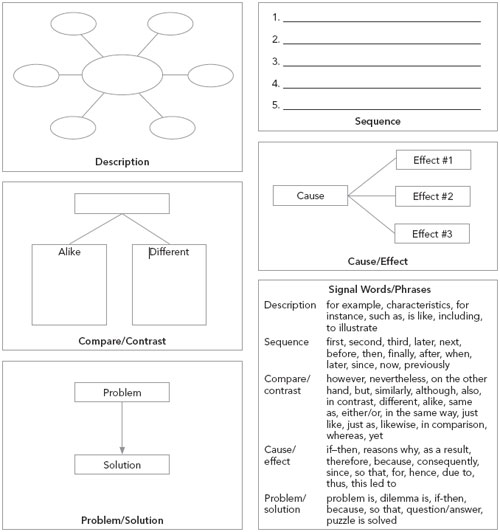Over the past 60 years, reading comprehension has changed its emphasis from the mastery of skills and subskills that are learned by rote and automatized to a focus on learning strategies, which are adaptable, flexible, and, most important, in the control of the reader (Dole, Duffy, Roehler, & Pearson, 1991). One of the most efficient strategies for which there is an influx of research and practice is training students on text structure knowledge to facilitate their comprehension of the expository texts.
Readers of all ages must be aware of text structures if they are to be most successful (Meyer, 2003). The structure or organization of the text is the arrangement of ideas and the relationships among the ideas (Armbruster, 2004). Readers who are unaware of the text structures are at a disadvantage because they do not approach reading with any type of reading plan (Meyer, Brandt, & Bluth, 1980). However, readers who are familiar with text structures expect the information to unfold in certain ways (RAND Reading Study Group, 2002).
Students first learn to read narrative text structures, which are story-like structures that facilitate their learning to read. Consequently, students enter school having a sense of narrative structures as they appear in texts. Across the years of school, their awareness of text structures must increase as they progressively shift from reading a story line or casual text to reading for information (Lorch & Lorch, 1996). By the third grade, and obviously by the fourth, there is a noticeable shift to reading texts for information, information that is often dense and written in long passages (Gillet, Temple, & Crawford, 2004; RAND Reading Study Group, 2002).
According to The Nation’s Report Card (National Center for Education Statistics, 2009), no significant differences in achievement of fourth graders were observed across groups. A part of this could be due to the ineffectiveness of current teaching techniques applied in reading classes. Reading teachers may find teaching text structure for expository texts an effective technique to improve reading achievement averages.
Why teach expository text structures?
Most expository texts are structured to facilitate the study process for prospective readers. These texts contain structural elements that help guide students through their reading. Authors of expository texts use these structures to arrange and connect ideas. Students who understand the idea of text structure and how to analyze it are likely to learn more than students who lack this understanding (RAND Reading Study Group, 2002). The research literature in this field reveals that students’ reading comprehension skills improve when they acquire knowledge of texts’ structural development and use them properly.
Carrell (1985) argued that instruction on text structure indeed has a positive effect on the students’ recall protocols. Meyer (1985) stated that knowledge of the rhetorical relationship of the ideas-main idea, major ideas, and supporting details-helps readers with their comprehension of the expository texts. Reading researchers have argued that knowledge of text organization or structure is an important factor for text comprehension (see Aebersold & Field, 1997; Fletcher, 2006; Grabe, 1991, 2004, 2008; Hall, Sabey, & McClellan, 2005; Horiba, 2000; Kendeou & van den Broek, 2007; Meyer, 2003; Meyer & Poon, 2001; Snyder, 2010).
Text features can help readers locate and organize information in the text. For example, headings help introduce students to specific bits of information. Presenting information in this manner helps students hold each bit of information in their short-term memory. Students then can process it or connect it to background knowledge and store it in their longterm memory. Without headings, information would be overwhelming, making it difficult to be processed effectively.
Structural elements in expository texts vary; therefore, it is important to introduce students to the components of various texts throughout the school year. It is also important to teach and model the use of these components properly at the beginning of the school year. The recognition and use of text organization are essential processes underlying comprehension and retention. As early as the third grade, students are expected to recognize expository text structures. Meyer (1985) classified these text structures as follows:
- Description: The author describes a topic.
- Sequence: The author uses numerical or chronological order to list items or events.
- Compare/contrast: The author compares and contrasts two or more similar events, topics, or objects.
- Cause/effect: The author delineates one or more causes and then describes the ensuing effects.
- Problem/solution: The author poses a problem or question and then gives the answer.
The ability to identify and analyze these text structures in expository texts helps readers to comprehend the text more easily and retain it longer. To achieve better results, it is highly recommended to introduce and work on text structures in the order prescribed in what follows.
How to teach expository text structure
Tompkins (1998) suggested the following three steps to teach expository text structures:
- Introduce an organizational pattern: The teacher introduces the signal words and phrases that identify each text structure and gives students a graphic organizer for each pattern.
- Give students opportunities to work on the text: The teacher provides the students with chances to analyze the text structures in informational books, not stories. At this stage, students learn the signal words and phrases in the text that identify each text pattern. They also may use graphic organizers to illustrate these patterns.
- Invite students to write paragraphs using each text structure pattern: The students’ first writing activity should be a whole-class activity, followed by small-group, partner, and independent writing activities. This involves selecting a topic and using a graphic organizer to plan the paragraphs. Finally, the students write a rough draft using signal words and phrases for the text structure, revise, and edit the paragraph to produce the final product. The teacher can then repeat these steps for each of the five text structures to ensure a comprehensive text structure coverage.
Having applied the procedure recommended by Tompkins (1998), we would like to share our own experience in teaching expository text structure and shed more light on the practical aspects of teaching text structure in reading classes. The first and most important thing for you as a teacher is to be well informed about different text structures for expository texts, the signal words and phrases for each text structure, and the appropriate graphic organizer specific to each text structure.
Before you prepare any instructional plan to start training students and embark on reading activities, you must model all the procedures. Meanwhile, the students watch you focusing on the steps you have mentioned, from recognizing the signal words and phrases to applying the graphic organizers to each text. After you have practiced for the first few sessions and students have collected enough background on what they are going to do, it is time to use the following recommended procedure:
- Introduce the text structures in order, starting with description and finishing with compare/contrast. This order is followed in most textbook readings.
- Introduce and work on a single text structure in each lesson. Do not combine them. Work on one text structure for three or four sessions, then proceed to the next one.
- Prepare short passages (about six to eight lines) for the text structure you are going to work on in that session. As the texts are short, you can work on at least four texts according to the time allocated for each session.
- Try to highlight and emphasize the signal words and phrases in each text and elaborate on a series of signal words for each text structure (see Figure 1). Tell students that authors of informational texts use specific signal words and phrases for each rhetorical structure.
- After students are familiar with signal words and phrases, ask them to find these clues in structure of each text through signal words and phrases. Then, invite them to write some short paragraphs and use some of the signal words and phrases appropriate to each text structure.
- Working with graphic organizers is the next step after teaching signal words and phrases. For the first few sessions of working with graphic organizers, prepare for your students a completed graphic organizer before they start working on the text. This will help them create a better image of the hierarchy of ideas and their interrelationships discussed in the passage. Graphic organizers help students list major ideas under the main idea of the text and put the supporting details under the related major idea. Having a graphic representation of the text’s ideas helps readers comprehend and retain the content.
- Once students are comfortable with different kinds of graphic organizers, you can give them an incomplete graphic organizer after they have finished reading the passage. Let them complete it on their own.
- At this stage, the students would be able to work on a blank graphic organizer independently, elicit the ideas from the text, and demonstrate the hierarchy of the ideas in a graphic organizer. These activities may vary from partially blank graphic organizers to totally blank schematic representations. Variables like the text length and text difficulty will determine how much of the text may appear in this schematic diagram.
Figure 1: Graphic organizers and signal words/phrases

Looking for graphic organizers?
Find downloadable templates here: Teaching Text Structure
As the students progress to the final stage, they are able to use the signal words and phrases as a clue to recognize the rhetorical structure of the text and create the appropriate graphic organizer for each text structure. They are capable of identifying the main idea, other major ideas, and supporting details of the text and put them in the graphic organizer to illustrate the subordination of the details to the main and major ideas.
Summary
As students progress through school, they face having to read challenging texts, texts that require them to read for information instead of simply reading for the text. Ask them to recognize the rhetorical fun. As students learn to read, they should learn to recognize different text structures so they can predict what type of information is included. Consequently, the basic need is for teachers to teach students to identify text structures and decide what information is most important in their readings.
Reading expository texts is critical for growth in reading ability and most urgent to rank normal achievers; the ability to read, comprehend, and analyze expository texts (i.e., identifying main idea, major ideas, and supporting details) could be good criteria to rank students’ academic reading achievement. One way to measure and rank students’ reading achievement of the expository texts is to teach reading through text structures. This will raise text structure awareness and is assumed to lead to a permanent improvement in reading skill.
Structure to Facilitate Reading Comprehension. The Reading Teacher, 64: 368-372. doi: 10.1598/RT.64.5.9Akhondi, M., Malayeri, F. A. and Samad, A. A. (2011), How to Teach Expository Text
